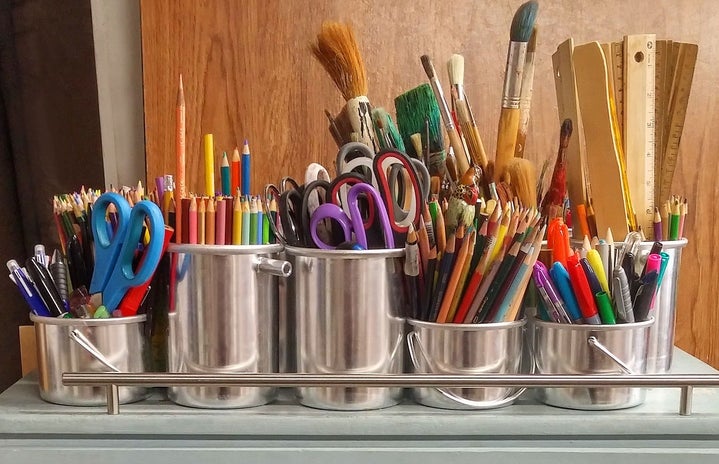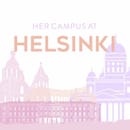If you haven’t had many classes in the University Main Building (and even if you have), chances are that you haven’t noticed there’s a museum there. A glass door on the second floor, tucked between the old elevators, leads to a surprisingly spacious room that holds the history of the university: the Helsinki University Museum. The room that has hosted the museum since 2015 is surprisingly big with both paintings and glass cases filled with historical items. The atmosphere is peaceful under a ceiling filled with small lights that slowly change in colour and intensity. We met Sten Björkman, Museum Director, whose expertise guided us through the exhibition.
This article is the first part of a 2-part mini-series on the Helsinki University Museum. This first part introduces us to the exhibition in the Main Building, whereas the second part will give us insight on what other responsibilities the museum has.
A Journey Through Time
“When the museum was moving to the Main Building in 2013, the administration of the university wanted the exhibition to tell ‘the story of the university’, which can be interpreted in many different ways”, Björkman explains. There was a lot to keep in mind when deciding how to present the story. “Besides the university community as a whole, the exhibition targets first year students as well as foreign students or researchers, who should be able to easily get a picture of the history of the university. But for visitors from the other side of the world the history of Finland – or even Europe – is not always very clear, so you’ll have to start from scratch. Because of the renewed university legislation, the museum also has to keep in mind the partners and donors of the university. Freshmen, foreign guests and potential partners alike should be introduced to the university in a clear and interesting way.”
The layout of the exhibition guides visitors from the 17th century until the present day. Divided into three parts, it follows the history of the university but also the history of Finland as a country. First there is the era of Swedish rule, from the 12th century to 1809. The university was first founded in 1640, but was then named the Royal Academy of Turku. Next there is the era of Finnish autonomy under the Russian empire, 1809-1917. During this time the university was moved from Turku to Helsinki, the new capital of the autonomous Finland, and was renamed the Imperial Alexander University. Finally, there is Finland from its independence until the present day and the University of Helsinki.
As Björkman explains, the history of the university has ever since its time as the Royal Academy of Turku (1640-1828) been closely linked to the history and culture of Finland. “All these eras have different features and contents, so in a sense it was quite easy to divide the exhibition into three parts. On the other hand, some things were difficult to divide like this. Take the expeditions, for example. The university has conducted expeditions from the very beginning, but where should they be placed in a limited space such as this?”
“The time period of our university as the Royal Academy of Turku is marked by the historical event of the great fire of Turku, in 1827, which destroyed all university buildings apart from the observatory”, Björkman laments. “As can be seen in the structure of the university’s art collections, older artworks were consumed by the fire, unless they had been placed elsewhere for some reason. In fact, parts of the library were actually saved because professors had disobeyed the rules by taking books with them to their countryside estates – it made it easier to work during holidays! A collection of medals survived the fire because as they crashed through the floor, they were lucky enough to fall on a layer of ash that kept them from melting.”
“Every generation thinks the changes they are facing are the biggest ones. But consider, when Turku burned down and the university was wondering what to do, a messenger of the Russian emperor brought orders that the university be rebuilt in Helsinki instead. First your town, your whole university is destroyed, and then they let you know you’ll have to move to Helsinki – a small fishing village at the time! In the eyes of national authorities, it was a logical move, but for the individual it was quite traumatic. Not only did they move all the collections, all the students, all the teachers and their families, all the furniture… They even took the doors!”
Here’s something to think about the next time you visit the Assembly hall on the old side of the Main Building. “The doors of the Assembly hall are from the Academy in Turku, as is the lectern,” Björkman reveals. There’s more. “Although we don’t have a lot of things from the 17th century, we still have for example the ceremonial sceptres, made in Stockholm in 1640.” At the museum there is indeed a case that holds the old sceptres. They are still in use, fulfilling their service in the conferment ceremonies at the university.
The great fire in 1827 was not the only disaster the collections have faced. “One of the few buildings in Helsinki to have been destroyed in the war was the old side of the University Main Building, which got hit in the 1944 bombings. This destroyed the collection of the history of medical science.”
The Stories Told by the Collections
As is the case today, the items of the collection have always been available to the public. In fact, the Finnish museum institution has its roots in the university: here we have the oldest collections, from the 17th century.
“Even though some of it has been destroyed, the university has always been a central player in the project that is building a national identity and culture. The exhibitions we have reflect this process,” says Björkman. “Nowadays one might not think about it, but in the early 19th century there could be new students who had never seen a piece of fine art until they came to the university. The university at the time collected casts of famous sculptures in order to have a public exhibition – not just for students – so that everybody could get an idea of what they were like. The university was the first art gallery. From the very beginning the university has served the public. For example, the Royal Academy in Turku performed autopsies in front of an audience. I think this tradition, the service of the general public, is a beautiful tradition that should be upheld, which the university does to this very day with its studia generalia lectures and the new Think Corner.”
“On the other hand, we have miniatures and models for teaching,” Björkman continues, stopping by a glass case that holds all kinds of curious looking objects. “In the 1800s, if you had only ever read about Roman soldiers, you didn’t really have a mental image of them. With the newest research of the time, you could get a much better picture. From the old Department of Hygiene, we have a miniature model of a water closet. With a model it’s much easier to explain how a water closet works. To the modern viewer many of the items here may look peculiar, but they were designed with a very specific use in mind.”
Unlike many great museums, the University Museum does not contain archaeological findings. Björkman explains why: “In many countries archaeological findings, usually made by universities, remain in the university’s possession. In Finland they belong to the National Museum, which was seen as a practical solution when the National Museum opened in the 19th century. As both the museum and universities belong to the state there was no question of ownership. That’s why our museum does not have archaeological findings from Finland, unless they have been deposited to us.”
The Power of Thought
So what exactly is the significance of a university museum? Who could benefit from it? The short answer is “anybody”.
“This university is not a “qualification factory” but an institution with long traditions, both in Finland and in Europe. Students should understand their roots”, says Björkman. “That’s why the museum and the administration try to strengthen the students’ sense of identity. It’s no quick process as big ships turn slowly, but we hope that next year all the new students could come visit us with their tutor groups. We want all students to understand that while the university has its traditions, it is a continuum constantly changing in its structure and content and always reacting to changes in society.”
In some ways the history of the university is also a crash course in the history of the country. Students, current, past and prospective, could benefit from seeing the chain their generations are part of, a chain that begun back in the 17th century. A proud institution, not a factory.
Our interview will continue in Part Two, where we learn more about what goes on behind-the-scenes of a museum.
Opening hours of the museum are Tue-Thu 12-17, Fri 12-16. More information for visitors can be found on the museum’s webpage.
All photos © by Maija Huitu



